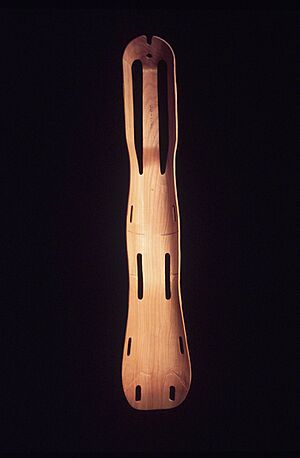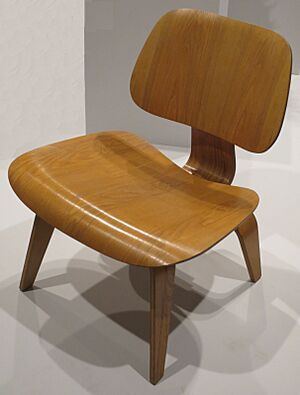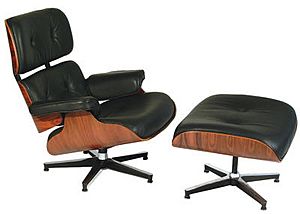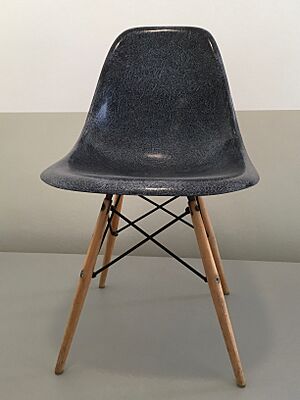Ray Eames facts for kids
Quick facts for kids
Ray Eames
|
|
|---|---|
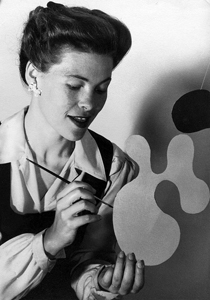 |
|
| Born |
Ray-Bernice Alexandra Kaiser
December 15, 1912 Sacramento, California, U.S.
|
| Died | August 21, 1988 (aged 75) Los Angeles, California, U.S.
|
| Nationality | American |
| Occupation | Artist, designer, filmmaker |
| Years active | 1936–1978 |
| Known for | Artist with Allied Artists Association, Hoffmann Studio and designer at The Eames Office, The India Report |
Ray-Bernice Alexandra Kaiser Eames (born Kaiser; December 15, 1912 – August 21, 1988) was an American artist and designer. She worked with many different types of art and design.
Ray Eames worked closely with her husband, Charles Eames, at their company, The Eames Office. Together, they made huge contributions to architecture, graphic design, textile design, films, and furniture. The Eames Office is most famous for its furniture, which is still made today. Charles and Ray Eames are seen as two of the most important creative people of the 20th century.
During her life, Ray Eames did not get as much recognition as she deserved. However, after her death, her work has been celebrated more in books, museum shows, and documentaries.
Biography
Early life
Ray Eames was born in Sacramento, California. Her parents were Alexander and Edna Burr Kaiser. She had an older brother named Maurice. Her family called her Ray Ray. Ray's father managed a vaudeville theater in Sacramento. Later, he became an insurance salesman.
The family lived in an apartment for a while, then moved to a house outside of town. Her parents taught her to value things that bring joy. This idea later helped her create new furniture and toys. They also taught her to enjoy nature.
Work and Education
Education
Ray Eames finished Sacramento High School in February 1931. She was part of the Art Club and helped decorate for school dances.
In 1933, Ray graduated from the May Friend Bennett Women's College in Millbrook, New York. Her art teacher there was Lu Duble. After college, she moved to New York City. There, she studied abstract painting with Hans Hofmann, who was Duble's teacher.
New York Work
In the 1930s, Ray's main artistic focus was painting. In 1936, she helped start the American Abstract Artists (AAA) group. She showed her paintings in their first show in 1937 in Manhattan. The AAA group helped promote abstract art when many galleries would not show it. Ray was an important person in the New York art scene. She was friends with other famous abstract artists like Lee Krasner. One of her paintings is in the Whitney Museum of American Art. Sadly, much of her early art was lost.
Ray lived alone in New York City until she returned home to care for her sick mother. Her mother, Edna, passed away in 1940.
Cranbrook Academy
By September 1940, Ray thought about moving to California. Her architect friend, Ben Baldwin, suggested she study at the Cranbrook Academy of Art in Bloomfield Hills, Michigan. At Cranbrook, Ray learned many different arts, not just painting.
Life and Work with Charles Eames
At Cranbrook, Ray met Charles Eames. He was the head of industrial design there. Charles was married with a child, but he soon divorced his first wife. Charles and Ray got married in 1941. Ray then changed her name from Kaiser to Eames.
They moved to Los Angeles, California. There, Ray and Charles Eames began a very successful career in design and architecture.
The Eames House
Charles and Ray were asked to join the Case Study House Program. This program was run by Arts & Architecture magazine. It aimed to show examples of affordable modern homes using wartime and industrial materials. John Entenza, the magazine's owner, saw how important Charles and Ray's ideas were. He also became a close friend to them.
In 1945, Charles and Eero Saarinen were hired to design Case Study House number 8. This house would be Charles and Ray's home. It was on a five-acre piece of land in Pacific Palisades, overlooking the Pacific Ocean.
Because of material shortages after the war, the materials for their first house design were delayed. Charles and Ray spent time on the land, enjoying the eucalyptus trees and the ocean view. They decided to change their plans. Instead of the first design, they used the materials to build two separate buildings nestled into the hillside. Eero Saarinen was not involved in this second design; it was a full team effort by Charles and Ray. The materials arrived, and the house was built from February to December 1949. The Eameses moved in on Christmas Eve. It was their home for the rest of their lives. It is still seen as a major achievement in modern architecture.
The Eames Office designed a few more buildings. Many were never built. The Herman Miller Showroom in Los Angeles was built in 1950. The De Pree House was built in Michigan for the son of Herman Miller's founder. Projects that were not built include the Billy Wilder House and a national aquarium.
The Eames Office
Ray and Charles worked very closely together on all their designs.
Graphic design
Ray was largely responsible for the graphic and commercial artwork of the Eames Office. She designed 27 covers for the Arts & Architecture journal from 1942 to 1948. She also helped with the Eames furniture advertisements for Herman Miller starting in 1948.
Ray Eames had a great eye for shapes and colors. She was mainly responsible for the unique "Eames look." Her talent made the difference between a good design and an "Eames" design. Ray Eames did not make drawings, but she kept track of all projects at the Eames Office. She also organized and protected the huge collection of photos the office gathered over the years.
Textile design
In 1947, Ray Eames created several textile designs. Two of them, "Crosspatch" and "Sea Things," were produced by Schiffer Prints. This company also made textiles by famous artists like Salvador Dalí. Two of her textile patterns won awards in a competition held by the MoMA. She also worked on graphics for ads, magazine covers, posters, and invitations. Original examples of Ray Eames' textiles are in many art museums. Her textile patterns have been re-released by Maharam.
Plywood design
From 1943 to 1978, the Eames Office created many furniture designs that were sold commercially. Many of these used plywood. The first plywood piece the Eameses made was a splint for the U.S. Navy.
The idea came from a doctor friend who told them about problems with metal splints. Metal splints were made flat, but the human body is curved. Ray Eames had a background in fashion design, which helped. The splint looked like a clothing pattern, with cuts to shape the plywood to a soldier's leg. The Navy asked the Eameses to make 150,000 splints. Their company became the Molded Plywood Products Division of Evans Plywood. The money from the splints allowed Charles and Ray to make more products and experiment with plywood furniture.
The Eames splint used bent plywood, which was a big step forward for their designs. They later used the same bent plywood in their famous Lounge Chair Wood (LCW) and the Eames Lounge Chair.
Popular furniture
Ray and Charles Eames worked together to create their most popular furniture.
Lounge Chair Wood (LCW)
Charles Eames, Ray Eames, and Eero Saarinen used what they learned from making Navy splints to design chairs. The chair they designed won a contest at the Museum of Modern Art. Production by Herman Miller began in 1946.
Time magazine called it the best design of the century in 1999. Time wrote that "Eames took technology to meet a wartime need (for splints) and used it to make something elegant, light and comfortable. Much copied but never bettered."
Lounge Chair
In 1956, the Eameses introduced their Lounge Chair. This fancy chair combined molded plywood with soft cushions. These chairs are still made today and are seen as a symbol of luxury. Charles Eames said its upholstery wears "like a well-used first-baseman’s mitt."
Shell Chair
The Eames Fiberglass Shell Chair was first sold in 1950. It was created in 1948 for a Museum of Modern Art competition for low-cost furniture. With its entire seat made of plastic, it was a completely new idea. The chairs were made in unique colors for that time.
The first shell chairs came in three colors: Parchment, Greige, and Elephant Grey Hide. Less than a year later, three more colors were added: Seafoam Green, Lemon Yellow, and Red Orange. These six colors were the "first generation" of Eames shell chairs, made from 1950 to 1954.
Films
These films were created by Charles and Ray Eames for the Eames Office:
- Traveling Boy (1950)
- Parade or Here They Come Down Our Street (1952)
- A Communications Primer (1953)
- Bread (1953)
- House (1955)
- Day of the Dead (1957)
- Toccata for Toy Trains (1957)
- Glimpses of the U.S.A. (1959)
- An Introduction to Feedback (1960)
- Symmetry (1961)
- Topology (1961)
- IBM at the Fair (1964)
- Aquarium (1967)
- A Computer Glossary (1968)
- Tops (1969)
- Alpha (1972)
- Computer Perspective (1972)
- SX-70 (1972)
- Powers of Ten (1977)
- Atlas (1979)
The Eames Office's Legacy
The Eames Office is often remembered mostly for its furniture. However, Ray and Charles had a broader design idea. They were also filmmakers, information designers, and thinkers about design. The New York Times wrote in 2015 that "By the mid-1950s, the Eameses had become as important to the American computer company IBM as they were to Herman Miller," the Eames furniture maker. Ray and Charles believed that design was "a way of life." They applied this belief to everything they did.
The Eameses deeply valued good craftsmanship. They learned a lot from their research trips to India, Japan, and Mexico.
Ray and Charles were known for making high-quality objects. They were both very dedicated to their work. For example, when creating the Eames Lounge Chair, they tried 13 different versions of the armrest before choosing the final one.
Later years
The Eames Office slowed down after Charles Eames died in August 1978. Ray Eames worked on several unfinished projects. She also advised IBM, published books, gave talks, accepted awards, and managed the Eames archives. She organized about 1.5 million two-dimensional objects and gave them to the Library of Congress to be kept safe. She wrote a book about all Eames Office projects. In her last years, Ray hosted many student groups and was planning to host members of the American Institute of Architects at her house.
Ray Eames died in Cedars Sinai Hospital, Los Angeles, California, on August 21, 1988. This was exactly ten years after Charles died. They are buried next to each other in Calvary Cemetery in St. Louis. The Eames Office closed completely after Ray's death.
Legacy
To celebrate what would have been Ray's 100th birthday, Vitra named a street at its Basel Campus "Ray-Eames-Strasse 1" in her honor.
On February 23, 2013, an exhibition called "Ray Eames: A Century of Modern Design" opened at the California Museum in Sacramento. The exhibition lasted for one year. It showed work Ray made before she met Charles in 1941, as well as work from The Eames Office.
Ray Eames, along with Charles Eames, wrote the India Report. Based on this report, the Government of India set up the National Institute of Design in Ahmedabad, India.
Recognition
Ray Eames' contributions to the Eames Office were often ignored during her lifetime. People sometimes said that Ray was not a very important part of the Eames Office. For example, when the Eameses were on The Today Show in 1956, the host said the chair was "designed by Charles Eames," not by both Ray and Charles. The host then said, "when there is a very successful man there is an interesting and able woman behind him." Then, the host introduced Ray, saying, "This is Mrs. Eames, and she’s going to tell us how she helps Charles." The media almost always said the work was Charles', sometimes only mentioning Ray in a small note.
However, in recent decades, Ray's work has received more attention. In 1990, a design historian named Pat Kirkham interviewed Ray Eames. Kirkham wrote that it was hard to tell whose ideas were whose because Charles and Ray worked so closely. Charles Eames always said that Ray's role was essential to their work together.
Ray Eames has also been recognized after her death for her personal fashion style. The New York Times described it as "too maidenly to be echt-bohemian, too saucy to be quaint."
Awards
- 100th Anniversary Gold Medal (craftsmanship and excellence in furniture design and execution): American Institute of Architects (AIA), with Charles Eames, 1957
- Emmy Award (Graphics), "The Fabulous Fifties", with Charles Eames, 1960
- Kaufmann International Design Award, with Charles Eames, 1961
- Women of the Year 1977: California Museum of Science & Industry Muses, Los Angeles, 1977
- 25 Year Award: American Institute of Architects (AIA), with Charles Eames, 1978
- Gold Medal: Royal Institute of British Architects (RIBA), with Charles Eames, London, 1979
- Gold Medal: American Institute of Graphic Artists (AIGA), with Charles Eames, 1977
- U.S. Postal Service Stamps, Charles and Ray Eames, 2008
See Also
- National Institute of Design
- The India Report
See also
 In Spanish: Ray Eames para niños
In Spanish: Ray Eames para niños


